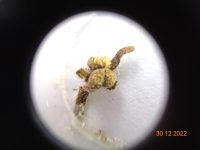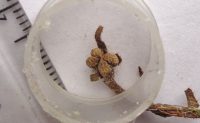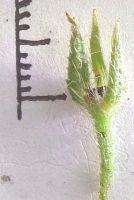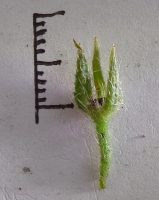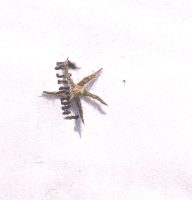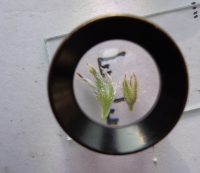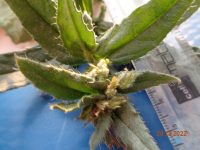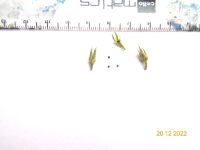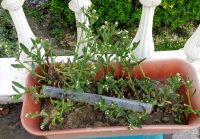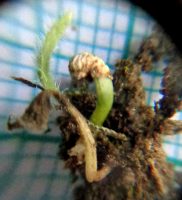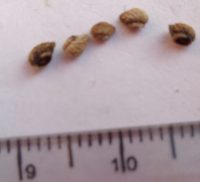
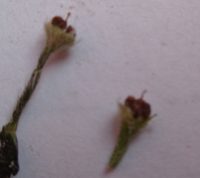
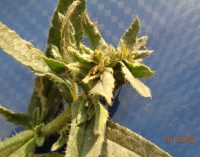
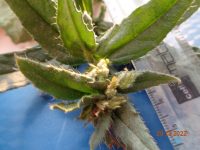
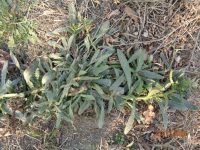
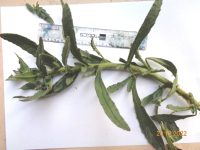
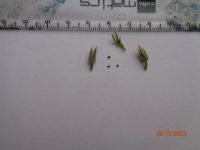

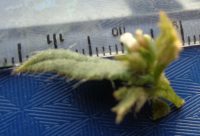
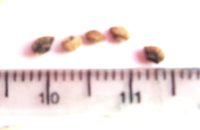
Stone seed (Lithospermum arvense(L.)) from Srinagar: 10 images.
Am posting photos of a herb of the forget -me- not (borage)family which I think is Lithospermum arvense(L.) Syn Buglossoides arvensis (L) a.k.a stone seed, field gromwel, corn gromwel . I request confirmation of I.D.
The herb was growing in a field in Srinagar and the photos were taken a few days back. It is a rather uncommon weed.
It is very hairy (see photos). It has tiny white flowers. The fruit has four brown nutlets (schizocarps). The nutlets are triangular ovoid and with small tubercles (See photo). According to Wikipedia its seeds stored in clay pots have been found in sites dating back to 4000 B.C. Because of the high level of Omega-3 fatty acids in its seeds its commercial cultivation has been started in U.K. it is patented and has trade marked cultivar (Ahiflower)(A plant native to this region is finding great interest in E.U. and U.S. while most people here are unaware of its existence!). According to the Flora of China its roots yield a purple dye.
The info about roots yielding a purple dye in the above post is not from Flora Of China.
It is from elsewhere.
I regret giving the wrong reference.
It appears close to images at
https://efloraofindia.com/2021/07/27/nonea-edgeworthii/
Looks different from images at
https://efloraofindia.com/2012/06/18/lithospermum-arvense/
Thanks for giving the correct I.D.
With reference to N.edgeworthii till Oct 1971 it was reported only from Jammu from Northwest India and Kashmir (SMA Kazimi: A Revision Of The Boraginaceae of West Pakistan And Kashmir(1971), Journal of Arnold Arboretum,p675.). Jammu has a climate and topography very similar to Haryana from where also it was later reported as per your link. Thus I think my post would perhaps be the first report of its presence in the valley if the ID is correct. Would specially like … opinion as he is an expert on the flora of the valley.

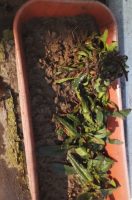
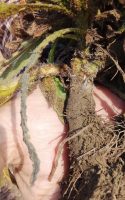
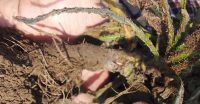
Would like to add the following info regarding the plant:
4 images.
Another species reported in BSI flora of India is Nonea pulla (L.) DC. (which though perennial as per Flora of Pakistan and has red or dark blue to purplish flowers) looks different as per GBIF. Also see keys in Flora of Pakistan.
Thanks for the links
Jammu and Kashmir Valley are completely different topographically and with very different climatic conditions. Jammu is like Panjab with which it merges but Kashmir Valley is separated from them by the Pir Panchal Range of mountains and climatically and topographically very different. SMA Kazimi whose name is mentioned on the herbarium sheet has in his 1970 paper mentioned that in Kashmir it is reported from Jammu only. BSI also mentions Jammu and Kashmir and not Kashmir valley and if the info is from 1970 paper of Kazimi then it would mean Jammu part of J and K.I would be grateful if someone would give a reference of it being reported from Kashmir Valley. … has posted photos of L.arvense from Kashmir Valley but not of above mentioned plants as far as I know.
There is another similar looking species i.e. Gastrocotyle hispida (Forssk.) Bunge, but it is different. Pl. see
https://powo.science.kew.org/941604-1
http://www.efloras.org/object_page.aspx?object_id=93142&flora_id=5
Nonea edgeworthii is also a medicinal plant as per
https://www.isisn.org/BR17(3)2020/1996-1999-17(3)2020BR20-154.pdf
So it is also possible that it was either cultivated or may have escaped cultivation.
Or it has spread in that area from Jammu.
… who is very familiar with the flora of the valley and indeed the author of a book on Taxonomy can perhaps guide us regarding the same.
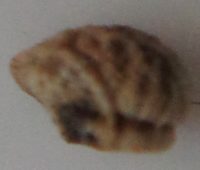
Am posting magnified photo of a fruit seen through a magnifying glass to show dorsal surface ridges and what seem to be tubercles. Collar is clearly visible. Length of fruit is about 3mm.
1 image.
Does it match with seeds of N.edgeworthii or not?
I do not have photo of nutlet of N.edgeworthii to compare with but Kazmi’s paper says “nutlets slightly rugose with white spots”. I am unable to see white spots. I also feel that it is somewhat more than slightly rugose.
See nutlet of Nonea caspica (Willd.) G. Don (Nutlets transversely oblong, 2.5-4 mm, dark brown to black, back rugulose, pilose, often freckled white. Basal ring 1-1.5 mm broad, ridge denticulate with 14-18 minute teeth)
http://www.efloras.org/object_page.aspx?object_id=93138&flora_id=5
Flowers of this herb are white and I can not see any white spots on the nutlet which is quite clear from the photo.
If there were white spots they would be easily seen
And Flora of British India gives the following details:
Nonea pulla (L.) DC.
Lamk. et DC. Fl. Fr. iii. 626, in note ; erect, hairy, leaves oblong acute upper subamplexicaul lower petioled, calyx-lobes acuminate, corolla blackish-purple, stamens included. DC. Prodr. x. 32 ; Reichb. Ic. Fl. Germ. t. 1302, fig. 2 ; Boiss. Fl. Orient, iv. 166. N. taurica, Ledeb. Fl. Ross. iii. 112. N. Edgeworthii, A. DC. Prodr. x. 30. Lycopsis pulla, Linn. ; Jacq. Fl. Austr, ii. t. 188 ; Gaertn. Fruct, i. 327, t. 67. Anchusa pulla, Bieb. Fl. Taur. Cauc. i. 125.—Boraginearum sp., Edgw. in Hook. Journ. Bot. ii. 284.
PUNJAB PLAIN, Thomson, Edgeworth, &c.—DISTRIB. Central and E. Europe, W. Asia.
Much branched, 12-18 in., hispid and villous. Leaves 2 by 1/3 in. Racemes 2-5 in., dense ; pedicels 1/8-1/4 in. ; bracts 1 in., leaflike. Calyx 1/4 in. ; in fruit 1/2 in., the campanulate base 1/4 in. diam. ; subglobose. Corolla-tube 1/4 in., narrow ; lobes 1/6 in., half-spreading. Nutlets 1/6 in., obliquely curved inwards, slightly wrinkled, puberulous.
Here the corolla is white
It is definitely a Nonea as general shape of nutlet is just like in the sketch of caspica but details do not match. No white spots as in capsica or edgeworthii.
More details are available at
https://ijlsci.in/ls/index.php/home/article/view/538/364
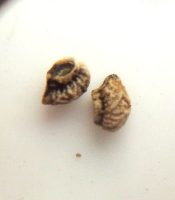
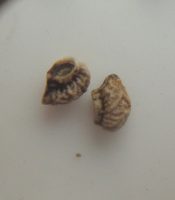
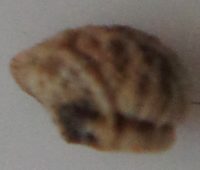
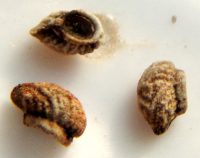
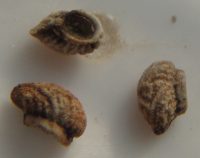
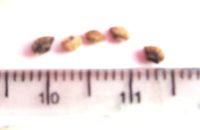
Am posting some more images of nutlets (photo through a magnifying glass) along with some older photos for reference:
As morphology of nutlets is characteristic of species I think any expert familiar with the morphology of Nonea nutlets can easily identify the species with the help of these photos. I would request any expert in India or any other country to help us regarding the same. However the following points which I have gleaned from my survey of literature available to me (including Kazmi’s landmark work available at JSTOR) would be of interest to members:
6 images.
I think the collar is denticulate here, by seeing the 5th and 6th images.
Pl. see
http://secure.environment.gov.au/biodiversity/abrs/online-resources/glossaries/vascular/lmargin.html
Regarding denticulations it could be as I have no previous experience of studying seed morphology.. Wish some person with more experience in nutlet morphology would opine on this.
However one has also to consider annual nature and flowering season march-april of edgeworthii.
Also I am pretty sure and hope you will agree that if the plant I posted was an annual it would have died by early Dec. Then again why should an annual store food in a carrot like tap root? Wonder if the Haryana people checked the root of their specimen. Please ask them if you happen to know any of them. It would be very helpful for us. Also if they have any photos of the seeds so that we could compare these photos with them. As they have published a paper they must have kept a record but in the article for which you kindly provided the link there is only a description of the nutlets without any photos. I presume they must have seen sketched and photographed the nutlets before publishing.. If they would post the photos here it would be easy for us to compare my photos with theirs.
The attached reference has photos showing denticulations in Nonea nutlets of different species.
1 attachment
This illustration clearly shows the longitudinal denticulations projecting down from the ring below the collar like the teeth of a saw. These longitudinal denticulations are clearly absent from the photos of the seeds that I have posted. After seeing this illustration I have absolutely no doubt that the herb is not edgeworthy but a hitherto unreported species endemic to Kashmir Valley. It differs from edgeworthii in not having longitudinal denticulations, flowering in Nov-Dec and not being an annual. Because of the close resembelance of its seed to the seed of N.caspica it is probably genetically more related to it than to edgeworthy. As scientists we have to accept objective evidence no matter how surprising the result
Hope you further pursue it and publish with all the evidence.
That needs a lot of botanical expertise and also perhaps the flower needs to be dissected to show faucal hairs to prove it as Nonea. I am not sure as it is not my field. However I am thankful to you for insisting that it is not Lithospermum and compliment you for not accepting the obvious. The easy solution is often a wrong solution.
Sorry, should have written nutlets and not seeds. The term stone seed was in my subconscious
Get in touch with Botanical persons, who are in the field of publications, from your area.
The posting at your site is enough.
Posting photos of in situ nutlets of the herb.
3 images.
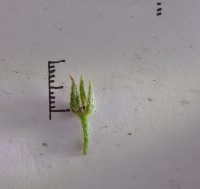
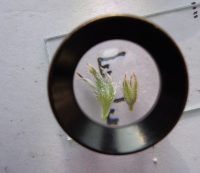
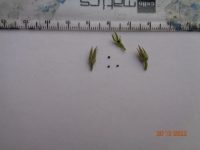
A Surprising fact about the calyx
Regarding the calyx Kazmi in his authoritative work writes under the heading Nonea Medicus, Philos. Bot.1:31.1789.:
“Calyx 5-fid , shortly or for ½ of its length, never divided to the base, enlarged in fruit.”
(SMA Kazimi : A Revision Of The Boraginaceae of West Pakistan And Kashmir(1971), Journal of Arnold Arboretum,pp670-71.).
I had fortunately two flowers left in the plant I had transferred to the planter. I reexamined the calyx and found it is divided to the base. This is also evident in the fruit. (See photos). It thus seems to me that it is either a sub genus or something different. Would request the opinion of experts. Many features resemble the genus Nonea including position of anthers, gynobasic very short style morphology and attachment of nutlet which I will put in a subsequent post.
3 images.
Thanks, … But Flora of Pakistan says about Nonea edgeworthii A. DC. in DC. as ‘Calyx 6-7 mm long, up to 10 mm in fruit, dense hairy; lobes linear’
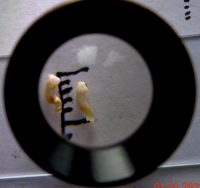
Thanks for the comment about FOP. Unfortunately their sketch does not show calyx. In fact they must have followed Kazimi the most towering authority there.
1 high res. image
Anthers
5 stamens inserted in the corolla tube just below the throat (Three are visible in the photo). The stalk by which they are attached (filament) is very short.
Peering from above one can see the anthers only in the intact flower. In this feature it resembles Nonea. They are brownish yellow (see photo)

Photo of Anthers
1 high res. image
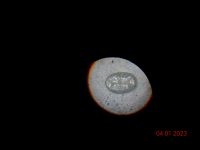

POLLEN
Am posting photos of pollen grains which I got by teasing the anthers on a glass slide with a pin. I managed to take the photos with a cheap “Students Microscope” to which I have added an oil immersion lens and my entry level digital camera (Sony DSC-W830). I think photos of pollen grains are a first for eflora as I have never seen them before. The pollen grains are prolate (cigar shaped) with a single longitudinal furrow (sulcus) running from pole to pole (monosulcate.)
3 images.
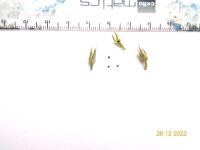
A photo of a herbarium specimen of N.edgeworthii A.DC. is available at gbif.org under creative commons (No Copyright) licence. This specimen has fruits a photo of which is attached below.(Attribution : “02910584.tif” – Nonea edgeworthii A.DC. collected in Pakistan. (licensed under http://creativecommons.org/publicdomain/zero/1.0/). (see Photo2)
The fruits in which the calyx is enlarged clearly show a calyx in which the lobes are joined and individual lobes can only be seen in the upper part (See photo2).
This is in accord with Kazmi’s assertion for Genus Nonea “Calyx 5-fid , shortly or for ½ of its length, never divided to the base, enlarged in fruit..”
This is as different from the calyx in the fruits of my herb as chalk from cheese. In the calyx of my herb the lobes are divided to the base.(See photo 1).
Comparison with the herbarium specimen of N.edgeworthii A.DC. puts all doubts to rest and conclusively establishes that my herb:
1. Is not N.edgeworthii A.DC.
2′. It does not belong to genus Nonea as the calyx lobes are divided to the base. However based on morphology of seeds and flowers it is closely related to Nonea Medicus.
It can be confidently asserted that it is a novel member of the Boraginaceae
2 images.
Somehow, I am not convinced as per GBIF specimen
With sincere regards and thanks for your incisive comments which have helped to crystallize our problem

Am posting a sketch of a typical seed of the plant. The tubercles present on and between the ridges are I think gland like structures that contain secretions. In nutlet morphology it greatly resembles the genus Nonea although its calyx is polysepalous while calyx of the members of the genus Nonea is invariably gamosepalous. It would be fitting to call it Apononea (apo=other). As posting these details under Stone flower is misleading I would be reposting all details in another thread to avoid confusion.
1 image.
For the information of any members who happen to visit this page I would like to mention that I have named this plant as Apononea bagathii Syed and have reposted it as the the thread “A Novel Member Of The Boraginaceae Family From The Kashmir Valley”. The link for this thread is given below:
https://groups.google.com/g/indiantreepix/c/doter
.
A Novel Member Of The Boraginaceae Family From The Kashmir Valley:
In late December I noticed an unusual weed growing in a field (34 / 02/ 43 N , 74/ 48/30 E ) in Srinagar. I misidentified it and posted it on efi website as stoneseed (Lithospermum arvense). … pointed out that it was not Lithospermum arvense and suggested that it was N.edgeworthii. As N.edgeworthii had never before been reported from the Kashmir valley I carefully reexamined the herb and after examining all the features have come to the conclusion that it is a novel species of the Boraginaceae family which has never before been reported from the Kashmir Valley. Indeed I suggested it could be named Apononea bagathii (Apo is “away from” and Bagath is the locality where it was found. The entire discussion can be viewed at: https://groups.google.com/g/indiantreepix/=footer
Although its habit very closely resembles N.edgeworthii and like N.edgeworthii its stamens are situated just below the throat in the corolla tube attached with very short filaments and the style is very short and included and the shape and morphology of its nutlets is very similar to that found in the genus Nonea yet it differs in having a calyx in which the lobes are divided to the base while the calyx of the members of the genus Nonea Medik is invariably 5 fid shortly or ½ of its length but never divided to the base and the tube is enclosing the nutlets. The presence of a calyx with lobes divided to the base and hence no tube enclosing the nutlets leaves us with no option but to put it in a separate genus. Some other ways in which it differs from N.edgeworthii are given below:
1. Nutlet does not have longitudinal denticulations
2.The bottom of the corolla tube is sinuous and not straight
3. It is not an annual as the plant which I transferred to a planter in late December is still thriving and seems to enjoy the subzero temperatures of( -5 C)-(-6 C) prevailing at present in Srinagar. This suggests that its real habitat might be alpine. The hairs might be having some natural antifreeze.
4. Its carrot like root also suggests that it might be a perennial.
For the above reasons I am posting it as a new thread. Over the next few days I will repost the photos and other data with this thread in which I hope to include a short review of existing members of Boraginaceae reported from the valley till now.
As Avery said in a letter to his brother “It is a lot of fun to blow bubbles but it is better to prick them yourself.” So I would request the members to prick this bubble and suggest a plausible ID for this herb.
It is my endeavor to correct any inaccuracies that tend to creep into an informal write up. I request the members also to make me aware of any discrepancies between the photos that I post and my written statements.
I hope somebody can shed more light on it.
All details are available at eFloraofIndia discussion post.
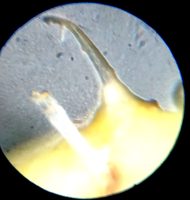
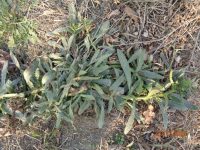

Habit: Herb about 15 cm tall. Stems branched from base. Hairy with short hairs mixed with long erect ones upto 2mm long. Both short and long hairs arise from a swollen base (See Photo of Hair (X 100 mag.) clearly showing the swollen base).
3 images.
Did not find Apononea bagathii anywhere in net and database.
Thanks for having a look at my proposal
OK. !



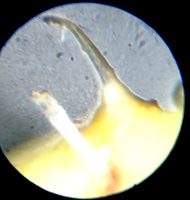
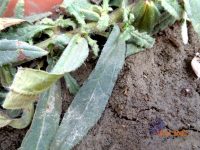
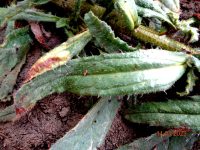
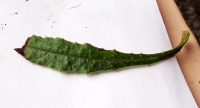
DETAILS OF LEAVES
Leaves lanceolate (Basal) to oblanceolate (cauline). Basal and cauline leaves 50-100 X 20-10 mm. Basal leaves sessile or almost sessile. Cauline leaves with winged petioles. Leaves covered with small and large erect hairs similar to those on the stem and like them arising from swollen bases. These swollen bases appear like numerous small swellings (tubercles) to the unaided eye (see photos).
7 images.


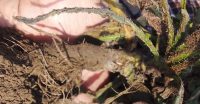
Details of the root of the herb:
While transferring the herb to a planter i noticed that it has a thick tap root like a carrot (see photos) and if its function is food storage then it supports the view that the herb is either a biennial or a perennial. The herb is still doing tolerably well in the planter nearly a month after its transfer but so far none of the seeds which I placed on moist sand have germinated. Maybe they need some exposure to low temperature before they (hopefully) germinate.
3 images
Details of calyx:
Calyx hairy, accrescent, 4-5 mm but 5-6mm in fruit. 5-fid, divided to the base (This distinguishes it from the genus Nonea in which the calyx is never divided to the base.) Calyx lobes surround the fruit.
7 images.
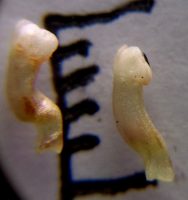
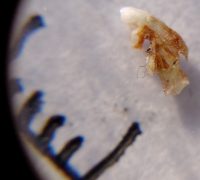
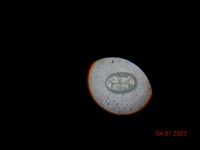
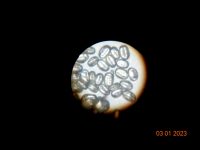
Details of corolla:
Corolla 4.5mm, white, infundibuliform. lobes 5, about 1-1.5mm long, broad, obtuse and crenulate. corolla tube 3mm long with a sinuous bend at bottom, Very delicately attached and tends to fall off easily {See photo)
Details of androecium:
Stamens 5, epipetalous, filaments very short, Stamens inserted below the throat in the middle of the tube (see photo), anthers about1mm long, included.
Pollen grains
cigar shaped (perprolate), monosulcate
4 images.
Would like to put on record that in near future I would be submitting a paper to Kew Bulletin “Apononea bagathii a new genus of Boraginaceae from Kashmir Valley” regarding which I have already placed some information for discussion among our group members as I am convinced that it is a new, so far unreported genus of the family. Would be grateful for a plausible, evidence based contrary opinion

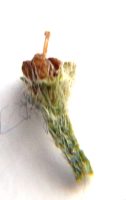



Details of gynoecium :
Ovary superior, style 2mm, gynobasic with flat base(see photo), about 1mm protrudes above the four nutlets, included, stigma bilobed
Note:
In PHOTO 2 two nutlets have been removed to expose the gynobasic style and flat base,
5 images.
That would be great.



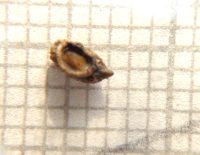
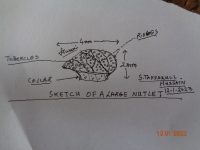
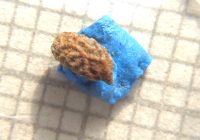

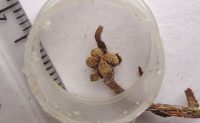
Details of nutlets.
Nutlets 4, yellowish brown, 3 mm long and 2 mm high, beaked, rugose, convex above, ridges prominent with tubercles between the ridges, attachment sub ventral, areola of thick prominent collar 0.4-0.5mm high, margin entire without denticulations
8 images.
3 images.
Note on reported genera of Boraginaceae from Kashmir:
Of these 17 genera twelve (12) genera i.e. those listed at Sr.No 1,2,3,4,5,6,8,10,11,15,16 and 17 are exclusively alpine/subalpine. Of the remaining 5 genera Lithospermum officinaleis described as a common weed in Kashmir.


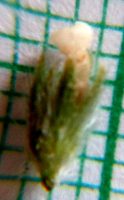

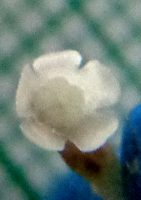
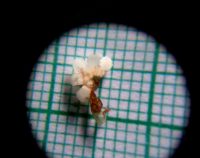
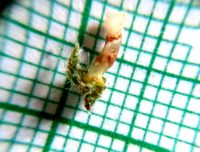
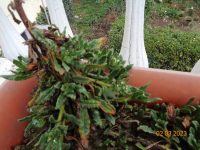
Updates on Apononea baghatii :
8 images- 1 high res.
2 images- 1 high res.
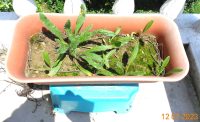
Update on Apononea baghatensis (Apononea baghatensis Syed is the name that I propose for this plant as till date none of the members have suggested an appropriate ID for the plant. Would request members to suggest a correction if needed.)
Photo of new seedlings from seeds that had fallen in the planter in April is attached . The plant is a biennial. These seedlings will grow into new plants and these will flower in March-April next year and then die.


